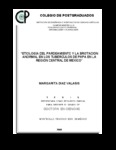| dc.description.abstract | El cultivo de la papa ha sido afectado por una enfermedad que induce el pardeamiento
y la brotación anormal en el tubérculo, a ésta se le ha denominado punta morada de la
papa (PMP). La PMP, asociada con un fitoplasma y Bactericera (Paratrioza) cockerelli,
se han encontrado relacionadas con este síndrome, son de importancia mundial y se
presentan en las principales zonas paperas de México. El objetivo de esta investigación
fue dilucidar con más precisión los agentes causales (B. cockerelli y fitoplasma)
involucrados en el pardeamiento y en la brotación anormal de los tubérculos de papa,
diferenciar el efecto independiente de los mismos en genotipos de interés nacional e
identificar los que puedan servir como fuentes de tolerancia a estas enfermedades. El
porcentaje de transmisión por injerto del pardeamiento y la brotación anormal en papa
de invernadero fue de 37%. Estos síntomas fueron inducidos por un patógeno
infeccioso, que logró ser transmitido mediante injertos sucesivos hasta seis veces a
través de diferentes genotipos de papa y chile. Mosca B, Alpha, Gigant, Lady Rosetta y
NAU-6, presentaron un pardeamiento de muy leve a leve, el resto de los genotipos un
pardeamiento de mediano a fuerte. El tipo de brotación anormal varió desde la falta de
brotes, hasta los brotes débiles. La detección de fitoplasmas asociados a esta
sintomatología en follaje, tallo y tubérculo mediante PCR, fue errática e inconsistente en
plantas mantenidas en invernadero. Sin embargo, el patrón de RFLP de tubérculo
sintomático de invernadero así como las secuencias de nucleótidos de los fragmentos
amplificados obtenidas de 2 muestras (follaje y tubérculo) con síntomas, sugieren la
presencia de un fitoplasma asociado al grupo amarillamiento del áster. La respuesta en
rendimiento y número de tubérculos fue drásticamente reducida en los 20 genotipos por
efecto de B. cockerelli, durante los dos años de estudio. Los síntomas de
“amarillamientos por psílido” en el follaje, pardeamiento interno en los tubérculos,
brotación prematura, brote fino y ausencia de brotación fueron inducidos por el psílido
bajo condiciones de invernadero y en ausencia de fitoplasmas asociados con la
enfermedad de la PMP. NAU-6, Alpha, Gigant y Lady Rosetta fueron tolerantes al
pardeamiento interno del tubérculo causado por el insecto, observándose similitud con
la tolerancia para PMP en los mismos genotipos, por lo que podrían ser utlizados como
fuentes de tolerancia. El síntoma de “amarillamiento por psílidos” no fue transmitido por
tubérculo, ni por injerto sucesivo, lo cual refuerza la idea de que metabolitos producidos
por el psílido son responsables de la sintomatología inducida. __________Potato cultivar has been affected by a disease that induces tuber browning and
abnormal sprouting, it has been named as potato purple top (PPT). PPT, associated
with a phytoplasma and Bactericera (Paratrioza) cockerelli, have been related to this
syndrome, are considered being of worldwide importance and are present in the main
potato regions of Mexico. The aim of this research was to elucidate with more precision
the causal agents (B. cockerelli and phytoplasma) involved in browning and abnormal
sprouting of potato tubers, to differentiate the independent effect of both in national
genotypes of importance, and to identify the ones that could be used as sources of
tolerance to these diseases. The transmission percentage of browning and abnormal
sprouting of greenhouse potato tubers was of 37. These symptoms were induced by an
infectious pathogen that succeeded successive grafting transmissions, up to six times
through different potato genotypes and pepper. Tuber internal browning ranged from
very low to low moderate in Mosca B, NAU-6, Lady Rosetta, Gigant and Alpha, and from
medium to medium high in the rest of the genotypes. Abnormal sprouting ranged from
lack of sprouts to the occurrence of weak ones. PCR detection of phytoplasmas
associated with greenhouse symptoms on foliage, stems and tubers was erratic and
inconsistent; nevertheless, RFLP pattern from a symptomatic greenhouse tuber, the
same as nucleotide sequences of the amplified products from 2 samples (foliage and
tuber) of potato, suggests the presence of an associated phytoplasma of the aster
yellows group. Yield and number of tubers response of the 20 genotypes was drastically
reduced by the effect of B. cockerelli, during the two years of study. Psyllid yellows
symptoms on foliage, internal browning of tubers, premature sprouting, hairy sprouts
and lack of sprouting were induced by the psyllid under greenhouse conditions and in
the absence of phytoplasmas associated with PPT. NAU-6, Alpha, Gigant and Lady
Rosetta were tolerant to tuber internal browning caused by the insect; a similar behavior
to PMP tolerance for the same genotypes was found, so they could be used as
tolerance sources. Psyllid yellows symptoms were neither tuber, nor successive grafting
transmitted. This strengthens the idea that metabolites produced by the psyllid are
responsible for the induced symptomatology. | es |

